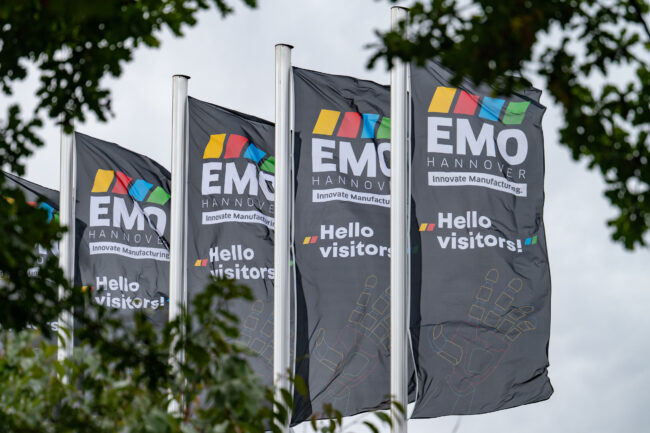
With 140 exhibiting companies, Italy represents the second-largest foreign delegation at EMO Hannover 2025, being held at the German exhibition centre from 22 to 26 September.
The strong Italian presence highlights the importance of the global stage for the country’s machine tool, robotics, and automation industries, which continue to view EMO as a key platform for international engagement. The event reaffirms the crucial role of foreign markets in driving growth and competitiveness.
Looking ahead, the next edition of the trade fair will return to Italy: EMO Milan 2027 is scheduled for 4 to 8 October 2027.
During the press conference held on Tuesday, 23 September, UCIMU–SISTEMI PER PRODURRE, the Italian association of machine tool, robotics, and automation system manufacturers, presented its revised 2025 forecasts for the Italian industry, prepared by its Economic Studies Department & Business Culture Centre.
Riccardo Rosa, President of UCIMU, commented, “Based on the latest order collection and the latest
deliveries by Italian manufacturers, regarding the second quarter 2025, the Economic Studies Department & Business Culture Centre had to revise the data presented just a few months ago. At the beginning of the year, we anticipated a slight growth in production supported by exports, but the current conditions of the context do not allow us to confirm this upturn today.”
Production is expected to attain 6,340 million euro (+0.2%), thus remaining stable compared to 2024. The final outcome is affected by the downfall in exports, as well as by the weakness of the activity in the domestic market. On the foreign front, Italian manufacturers’ sales abroad should stop at 3,895 million euro (-8.9%) compared to the previous year.
On the other hand, on the domestic front, deliveries should increase by 19.1% to 2,445 million euro, driven by the modest recovery in domestic consumption, which is expected to reach 4,230 million euro
(+14.1%). Despite double-digit increases, the absolute values estimated for these two economic indicators are still very low.
“Moreover – continued President Riccardo Rosa – what our Studies Centre has observed is that it is not possible to identify a clear trend for the sector. Rather, we see a pattern of upward and downward
fluctuations, reflecting the chaotic situation in the context.”
With regard to exports, in the period January-June 2025 (latest data available), Italian sales of machine
tools only decreased by 13.3% compared to the first half of 2024. The drop was generalised. The
exceptions were Poland, Mexico, Switzerland, the United Arab Emirates and Saudi Arabia. However, it
should be noted that, despite significant increases, the latter two still purchase very small quantities of Made in Italy machines.
The main markets for Italian exports were: the United States (292 million euro, -4.2%); Germany (127
million euro, -28.1%); Poland (97 million euro, +8.3%); France (97 million euro, -7.5%); India (85 million
euro, -14.1%).
Riccardo Rosa further added that, “These figures highlight that Germany is suffering, and with it, Europe and Italy in particular, whose companies are integrated within German value chains. Compared to Germany, the situation is particularly difficult both for the automotive industry – which is paying the price for the transition to electric motors – and also for the crisis in the construction sector. Our hope is that the 46-billion programme of the government, conceived to revitalise the Italian economy, will actually give a boost to the manufacturing industry”.
“Looking overseas, in the first six months of this year, despite President Trump’s numerous announcements and repeated retractions regarding tariffs, the USA remains our primary export market. The situation is rather complicated and still unclear. Apart from the tariff rates, what is most worrying is the uncertainty that this attitude has generated among industry operators. Owing to this, the entire export system has slowed down, not only for exports to the United States but also to the rest of the world.”
“With regard to Italy – concluded the president of UCIMU-SISTEMI PER PRODURRE – what we observed
over the last few months is a moderate but still too weak improvement in the attitude of the market, which was positively affected by the clarification and simplification of Transition 5.0. This is also confirmed by the trend in guaranteed months of production, which did not exceed 6.6 in the first half of 2025: it is better than in 2024 but still far from the results achieved in the previous years. In light of this, as we are approaching the final part of 2025, which coincides with the end of applicability regarding Industry 4.0 and Transition 5.0, we stress the need for a new industrial policy plan to support companies from 2026 onwards.”
UCIMU has already confirmed its availability to the Ministry of Enterprises and Made in Italy to participate in the working group that should lead to the drafting of a simplified measure. As announced by the Minister himself, this simplified measure will merge 4.0 and 5.0, thus facilitating its use for enterprises, a necessary condition for companies to use it.




COMMENTS